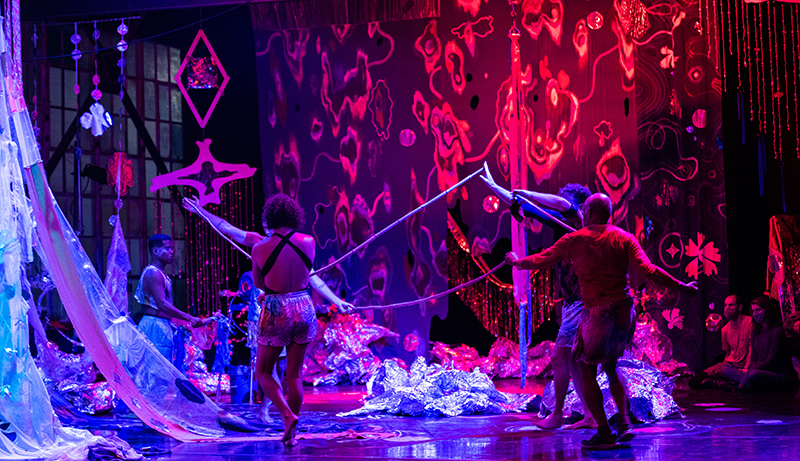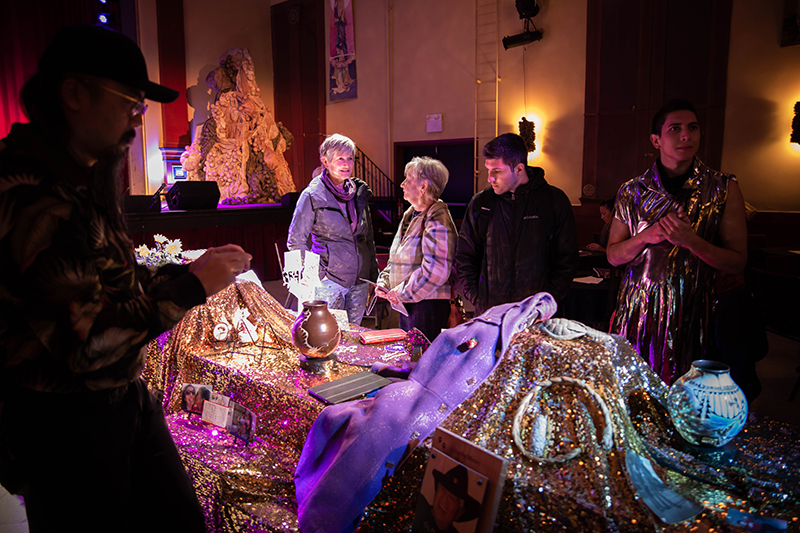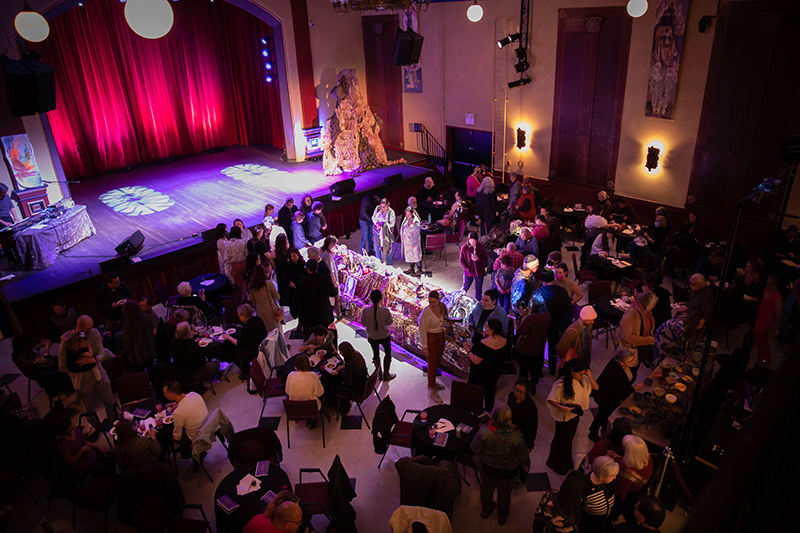Scores for Improvising with Ancestors
BY KEVIN O’CONNOR
Note: This essay was first published in Stance on Dance’s spring/summer 2023 print issue. To learn more, visit stanceondance.com/print-publication.
“Take me on tour.” These were the words Billy spoke before he died. He was letting us know to keep working with him as we continued our artistic exploration with the Sweet Labour Art Collective.[1] This collective is composed of dancers, choreographers, filmmakers, and storytellers co-instigated by Billy, a two-spirit visual artist, born on the Oneida Nation of the Thames and raised nearby in the city of London, Ontario. “Take me on tour” opened our thinking around how to cultivate practices for working together in a rehearsal process with our ancestor, Billy. His prompt was a provocation, a reminder, and a demand to rest in the complexity where pasts and futures can cohere and shape what working together across the life-death binary can do. It instigated a rehearsal process that led to a community-engaged performance called Compost: Recomposing Relations, which opened on November 8th, 2022, five years to the day after Billy died. Simultaneously to codirecting this event, I was involved in the creation of an improvised dance piece called TRY, with multigenerational queer and two-spirit dance artists based between New York City and San Francisco. TRY[2] opened at Z Space in San Francisco in November 2021. TRY is described as a queer improvised collaboration where body and land meet ancestry and futurity.

TRY, Z Space, San Francisco, Nov. 2021
Improvisors: Ishmael Houston-Jones, jose e. abad, Snowflake Calvert, Keith Hennessy, and Kevin O’Connor
Photo by Robbie Sweeny, #tryproject, Lighting by gg torres, Immersive installation by Monica Canilao and Kendra Azul~írís
Both the Sweet Labour Art Collective and the TRY artists came together through complex world-making practices. In the Sweet Labour Art Collective, these practices include adoption, immigration, resurgence practices, the forced removal of the Oneida people from their territory in what is today called New York State by the Treaty of Buffalo Creek in 1838, dance events in North America, and travel between the Oneida Nation of the Thames and the working-class neighborhood of SoHo in London, Ontario. My own Sicilian, Gaelic, and Irish ancestry became entangled with the Oneida, English, French, German, Chippewa, and unknown ancestors of the other members. Both the Sweet Labour Art Collective and TRY improvisers were composed of a “complex we” (de la Cadena 2019), coming from different places, with different sense-abilities and ways of worlding. As a complex we, being together included mutual excesses, uncommon practices, friction, and creative returns of that which escapes knowing.
One method to working with this complexity was to create scores that we would improvise. These scores were also a method for inviting diverse publics into a rehearsal, workshops, or performance as a mode of moving and thinking together. The scores allowed us to find a common interest to continue to work together without complying to sameness. They instigated a rehearsal space with the potential of infrastructuring new possible relational worlds into being. Within rehearsals, one can be trained to be affected by one’s own body (opening to the stranger inside) as well as another (humans, other-than- humans, and ancestors). Crafting and improvising within scores was one method shared by both artistic groups to create situations for the activation of new questions and different possibilities for dancing with ancestors.
Score 1
- Pour some water into a glass.
- Into the glass, name out loud all the ancestors (family, teachers, friends, other-than-humans) that have changed you (three minutes).
- Drink the water.
- Engage in a practice for 10-20 minutes (dance, write, walk, sit).
Snowflake Calvert and jose e. abad, two members of the TRY experiment, led a group of roughly 40 dancers via Zoom through this above score. The TRY members were on Fire Island, New York, where we had accompanied Ishmael Houston Jones during his three-week residency at the Boffo queer arts residency. From this island, the group cotaught a five-day workshop during the summer MELT Intensive produced by Movement Research in New York City. In engaging with this score, I was reminded of the words of queer Black feminist writer Alexis Pauline Gumbs, who states “who we are is beyond the limits (or container) of one lifetime.”[3] Drinking the water from the glass filled with the names of my ancestors, and feeling it quench my thirst as it coated the inside of my body, created a felt sense of the ways my bodymind has literally been shaped and is therefore constituted by many other beings, spaces, and times, including the ones I had named.
This score stuck with me and I used it as I wrote this piece of writing. I started by getting a glass of water, whispering the names of my ancestors into it, drinking the water, and writing for 20 minutes. In one writing session, I had a distinct memory of feeling myself as an eight-year-old moving in a “peanut machine” in an improvised dance class led by my first dancestor,[4] Anna, who was Billy’s adoptive mom. She offered free improvisation dance classes weekly to the neighborhood kids where I was raised. In one score, we would collectively build a peanut butter-making machine with our bodies so we could turn an imaginary pile of peanuts into peanut butter, as it moved through our mass of dancing bodies. We would play with cracking, pushing, pulling, mushing, pressing, stirring, and making peanut butter together. Each of our actions was affecting and being affected by the actions of the others. It became a game of turning a mundane product we ate and knew well into a magical process of making together. In hindsight, it was also a kind of togethering practice. By this I mean a practice to train a felt sense of interdependent bodyminds rather than independent ones.
Score 2: Altering Score (A practice for installing Billy’s artistic archive in the space)
- Gather Billy’s artistic material archive.
- Lay out everything in the periphery of the designated space, in a way where new relations between them can emerge. Set up a large table in the center of the space.
- Let yourself be lured by one of Billy’s objects. Pick it up, feel it, play with it, and let yourself be drawn to a place in the center installation. Install the object there.
- Back off to the perimeter of the space and attend to the center. Yield into the composition. How does it compose you? Play with walking around the composition, get close to it, and move far away. Take your time. Ask what is it doing?
- Repeat until all the objects are installed and then everyone move to the parameter of the space and notice what has been created.
- Allow yourself to be pulled into relation to the installation. Place your body amongst and in relation to the objects and come to a kind of stillness, or observe how somebody else “enters the installation” and comes into relation to the objects. Let the resulting composition move you. Once everyone is amongst the composition, collectively find a stillness.
- Without words, all move back to the parameter. The installation is ready.
- During the night of the community event, each audience member is invited to bring something (a photo or object) of an ancestor that they want to add to the altering installation.
How might we work with Billy’s artistic archive (paintings, drawings, pottery, costumes, and masks), keeping the archive in an emergent process? Emergence was a key concept that Billy worked with in his art-making practice. In 2017, at the age of 47, Billy died. Billy’s funeral ceremonies occurred both on the land where he was born, Oneida Nation of the Thames, in the traditional Longhouse, and in the SoHo community of London, Ontario, where he was raised with his adoptive family. Each site enacted different rituals and different ways of making death. In using the language of “making death,” death is understood as being made through various practices. Working with Billy’s artistic archive as an ancestral practice was a way of exploring making death and therefore making relations with Billy in new ways.
As we practiced the altering score, we would ask what a particular action of one of the collective members’ changes to the installation would do to the whole. The question “What does it do?” is different than “What does it mean?” We worked with doing because it trained us to attend to the differences that are made by our actions that changed relations in some way. “What does it do?” can be different for each of us. Whereas the question “What does it mean?” often got in the way of our creative process. It demanded a shared understanding, which was not necessarily a starting or ending point for our working together across different ways of worlding. “What does it do?” allowed each of us to track the ways we are uniquely changed by Billy, his material objects, and each other, while working in the altering score. The score allowed us to refeel and rethink our relations to Billy through his artistic material legacy and to place ourselves in the midst of them, together emerging into something new.

Audience members engaging with Altering Score
Performance: “Compost: Recomposing Relations,” Aeolian Hall, London, Ontario Nov. 2022
Photos by Michaela Altenburg
Score 3: Solo, Witness, Follow
A. Solo: Solo as many that you are (solo as spirit)
- Spirit implies I am never alone, all my peoples (past and future) with me, calling them in and dancing as them, my body is of them.
- Improvise with the physicality of what these relations have left you, including dancing as the many lands that shape you.
B. Witness: Active witnessing is an open stance of observing what is right in front of me
- Rest in the practice of deep listening to the incipient moment (the moment where there is infinite possibility for moving and being moved otherwise) in the other.
- Response-ability: Notice your ability to respond in infinite ways without formulating a particular singular response and notice the ways you and the others dancing keep open the possibility for another’s ability to respond.
C. Follow: Track the energetics and state of the one you are following; this is not mimicking but moving with the other without understanding
- Let yourself be made different by the one you are following, and feel your ability to respond and be moved.
- Can you follow moving in and out of sight or without sight?
Solo, Witness, Follow was a score jose e. abad and I created while coteaching a workshop. It was an iteration of a score called Solo, Neutral, Follow, by Sara Shelton Mann, a teacher who had worked with us during rehearsals in the TRY project. We put her score into variation as we thought about how we might use it to think with improvising in relation to our ancestors. This score can be practiced with three people or in duets with each person trying on one of the roles and then switching after a set amount of time.
This score trained us to dance as the many that each of us is. It starts by complicating the notion of the soloist. What is often read as a singular skin-bound body is felt, lived, and danced as many. Soloing in this score was a kind of body-boundary breakdown that demanded a refusal to be a singular self, or what Édouard Glissant motions towards when he talks about what it is “to consent not to be a single being” (Moten in Harney & Moten 2013). Following was a practice of yielding into being moved by the many that was soloing. And witnessing was a practice of resting in the complexity of it all and a training in tracking when the ability to respond (response-ability) for any one person was shut down by the action of another. Each role was also a practice of orienting the group to not knowing together. Not knowing is not “I don’t know,” or “I don’t know yet” (de la Cadena 2021); it is an active place of inquiry that slowed us down and offered creative returns.
The Sweet Labour Collective asked how we might keep decomposing and recomposing our relations with our friend and brother, Billy, after his death. How might we come into relation to our queer, two-spirit, and ancestral lineages? How might our practices now shape what it means to be a future ancestor for those to come? Part of Billy’s archive included his language journal. Brooke Chrisjohn, a member of the Sweet Labour Art Collective and children’s Oneida language teacher, translated this writing as part of the sound score in a dance film we made together. Billy wrote, “To love is to be medicine for another”.
Brooke translated it in the following way:
The Oneida word for “love” is kanolukhwasla.
The word for “medicine” is Onuhkwat.
If there is love there is medicine.
Ta:t tho kay^ kanolukhwasla ne: kih Onuhkwat.
In both dancing with Billy and working with TRY, what was foregrounded was how scores for improvising with ancestors was a practice of love, including grief, and a mode of being together in rehearsals across space and time. What became clear to me working with these scores was that each of us does not preexist our relations with ancestors as such, but materialize because of our ongoing relations with and as them.

Audience members engaging with Altering Score
Performance: “Compost: Recomposing Relations,” Aeolian Hall, London, Ontario Nov. 2022
Photos by Michaela Altenburg
~~
To learn more, visit www.ecologicalbodying.com or @sweetlabourart.
References:
de la Cadena, M. (2019). An Invitation to Live Together: Making the “Complex We.” Environmental Humanities, 11(2), 477-484.
de la Cadena, M. (2021). Not Knowing: In the Presence of…. Ballestero, Andrea, and Brit Ross Winthereik, eds. Experimenting with Ethnography: A Companion to Analysis, Duke University Press. 277-78.
Gumbs, Alexis Pauline. (2018) “We Stay in Love with Our Freedom: A Conversation with Alexis Pauline Gumbs.” Interview by Joy KMT, February 4, 2018.
Harney, S. & Moten F. (2013). The Undercommons: Fugitive Planning & Black Studies. Wivenhoe: Minor Compositions. p. 154
~~
Kevin O’Connor is a multidisciplinary artist whose work is rooted in collaboration, improvisation, community-engaged arts, somatics, ecology, and queer art practices. His artistic practice is situated between London, Ontario, and the San Francisco Bay Area. He is a co-instigator of the Ontario-based Sweet Labour Arts Collective. They engage with community-engaged art to examine practices of being together across worlds, which includes the ecological and social interactions between humans and non-humans. Currently, the collective is working on a new dance film exploring improvisation as a practice of care in institutional health settings.
[1] Sweet Labour Art Collective was instigated by Billy, Ruth Douthwright, and Kevin O’Connor and collaborated with the following artists: Brooke Chrisjohn, Montana Summers, Linda Jantz, Wormwood, Marshall Stonefish, Hanna Elias, and Meredith Jones.
[2] TRY was choreographed and performed by Ishmael Houston-Jones, jose e. abad, Snowflake Calvert, Keith Hennessy, and Kevin O’Connor with music by Gabriel Nuñez de Arco with jose e. abad in an immersive installation by Monica Canilao & Kendra Azul~írís and lighting design by GG Torres.
[3] For Alexis Pauline Gumbs, the container can have many names including heteropatriarchal capitalism, colonialism, and the Western idea of the individual life.
[4] I learned this concept from TRY dancer Keith Hennessy. It names deceased dance teachers or fellow dancers who have shaped your dancing body.

2 Responses to “Scores for Improvising with Ancestors”
Thanks Jimmy!
I loved reading every bit of this! 😀❤️
Comments are closed.